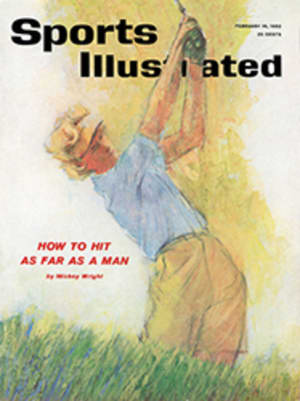
The Airy Mare with the Wild and Roving Eye
There comes a time in the career of every horseman or horsewoman when the urge actually to own a horse becomes overwhelming. I was no exception—it hit me when I was 18 and had been riding for 12 years. But instead of shopping around for just the right horse—I didn't have the sense or the money—I simply went to a neighbor who had bought two mares to breed and had found one of them barren. I watched this mare trot across the pasture for a few minutes and, because I liked the airy way she moved, decided she was the horse for me. I had only $100, but my neighbor was more than glad to get rid of the mare for that sum.
I quickly found that my newly purchased horse had many faults. She was a little mare, not quite 15.2 hands, but there was no delicacy about her, no prettiness. She was short-coupled, with a thick, unseemly neck that was too muscled and too masculine for a mare. Her mane was as coarse as mattress ticking and absolutely refused to lie on the off side no matter how hard a groom might work over it.
Beyond mere appearance, she was a rugged tomboy with a wild and roving eye. She lunged and she bucked and you could almost hear her cursing to herself when things didn't suit her. She carried her head too high, and almost broke my nose each time she tossed it. She tossed it often—in rage at me. She also had straight pasterns and a straight shoulder. These are conformation faults that guarantee rough gaits and an unpleasant ride.
I never knew many details of her life before she came to me. She had been foaled in Oklahoma, and at least she was a registered Thoroughbred, although her antecedents were nothing to brag about. An Army officer had named her, suitably I thought, Doxy Girl.
My early days with Doxy Girl brought friction, to put it mildly. She despised waiting her turn to jump at a crowded panel and took it out on me and adjacent humans by kicking back in all directions. For two years I never hunted her without the scarlet ribbon (badge of shame) braided into her tail. She ran up on the heels of whatever horse was in front of her, too, and when I hauled her back she flung up her head and knocked my teeth loose.
I got rebellious. I didn't like her tone of voice at all—and who was riding whom, anyway? I blistered my fingers keeping a tight hold, keeping her at the rear, taking back constantly to let others go ahead so that Doxy wouldn't damage them with her sharp iron heels. She began to sulk and stop at fences in retaliation. She loathed standing still at any time, but when I was trying to mount her she developed a new dodge: every time I got a toe in the iron and gave a mighty hop she would duck in toward the rail and toss me neatly overboard. Then she thought up something worse. Taking off toward a fence she would give a mammoth plunge—one great leap that, if it didn't unseat me, at least threw me off balance. Diving like a sprinter for the jump, at the last split second she would plant four feet like stakes of steel and stop dead.
Public humiliation
In this small hot war I began to weaken. New to hunting and timid anyway, I was first annoyed, then baffled, then downright terrified as each day's performance loomed up. The merry chase after fox and hounds became a dreary horror of public humiliation. I tried to comfort myself by reflecting that the other riders who sailed so superbly across country probably had $1,000 horses and that the Master had paid $3,000 for his well-mannered beauty. What did I expect, grinding along on a cheap western-bred plug? Small comfort this. Inside I knew the truth: I just couldn't ride Doxy Girl.
At last a friendly veteran horseman tipped me off: "You're wasting your time and hers," he said gently. "You're too busy riding her. Try being a passenger on her for awhile. See what you can learn from her instead of what you can teach her."
I gave her her head the next day, and she took it. She went right up front, thrusting boldly ahead of the field but (after she got over the shock of finding I had some courage after all) jumping like an Aintree winner. From that moment on she gave up kicking, and I abandoned the scarlet ribbon. I learned to think with her, not for her, to trust her feet, not guide them, and especially to throw my heart over the fence—as the old saying goes—knowing she would carry it and me and not let us down. From her pace I worried whether she would overrun hounds, but I discovered she had no intention of doing anything so gauche. Doxy Girl knew what this hunting business was all about, and when she knew that I realized she knew, we both got along famously.
Despite her considerable faults, and even though to this day we have never reached an affectionate footing (she considers any hint of affection nonsense), I have come to prize her for the many good qualities one often finds singly in a horse but seldom all in one package.
A speedy walker
First and foremost, she could walk. If you've ever fretted on that problem horse, the slow walker, you know what a blessing a long, true, ground-gulping walk can be. At the end of a day's galloping, when you're 14 dark, tiresome miles from the stable lights with rain coming on, it is worth anything to have a horse that can drop her head, ease her neck and walk fast.
Moreover, she could trot, and that's another attribute without price. Doxy Girl had two trots. Collected, she jogged along with her short little neck bowed in, her straight pasterns bouncing you a bit higher in the saddle than was comfortable. Extended, her reaching gait was something for the final heat of the Hambletonian. To cover a lot of country I would hike my stirrups a notch higher and sit well forward, posting from the kneecaps, while Doxy pounded out a tattoo that left other horses trailing and troubled.
My mare also had three canters. A certain set of signals (which it took me years to learn) would set her into a show-off style of going, high and slow with plenty of rock 'n' roll. She fought these signals, hating anything artificial, which, to her, the collected canter was. But she could do it. Let the reins out an inch and she'd stretch the gait into a hand gallop. Let her head go, take a jockey's seat, and she'd go into a dead run.
These gaits and the nimble pivot on the forehand or the haunches were surely taught her by her previous cavalryman owner. But her most brilliant asset was her footwork, and, at least in my experience, a horse is either born with this or does without.
Racing down a narrow trail spattered with roots, rotting logs and half-buried boulders, she moved like a deer, never stumbling or faltering. She sprang up rocky hillsides like a mountain goat and roared downhill or floated over groundhog holes and erosion gullies easily. Sloppy footwork (as I was to find out later, aboard other hunters) is a bit more frightening than blindness, more dangerous than riding a runaway.
There was the furious run in which we thundered downhill at a stiff rail fence and were in midair before I glimpsed a great heap of stones, neatly piled by some farmer, spread across our landing site. My stomach started to rise into my throat, but it never got there. The little prairie schooner beneath me stretched her fluid body, arched her back and set a front hoof precisely one inch beyond the stones.
She also displayed some other talents I had overlooked. One was the business of opening gates. As I reached for the latch she sidestepped conveniently and then weaseled through the gap, did a 90° turn and stood still while I closed it again, reversed and was off, hardly losing a stride. She never crossed swamps with the heaving squelching uproar most horses make. Doxy limbered her legs and hunkered down in some sinuous motion that got us through all the gook without a splash and almost without a sound.
At the barns the grooms loved her. She was an "easy keeper," staying fat and sassy on five quarts of oats a day—starvation rations by most hunter standards. She stood like a statue to be washed or clipped, and her stall was nearly as tidy as a lady's boudoir.
There was another day I remember vividly, a day when we came up from a stream bottom in strange country and found ourselves a single stride from an old, solid worm fence of vast proportions. Doxy Girl didn't bother with that stride. She walked to the fence, sprang—and soared. I went back to the place late in the afternoon, when hunting was over, and measured it: 5 feet 4 inches, and uphill besides. I was satisfied.
Later on I rode other horses—hunters I was lent or given, and a young one I schooled myself. They had a lot of winning ways. I liked the gelding with the gaunt barrel and the jumping rump who begged wistfully for Coca-Cola whenever he saw a bottle in my hand. I liked the mischievous son of Whisk Broom II who romped in every brook and puddle—and who chewed pieces out of two good saddles inadvertently left near his stall door. I liked the tall peaceful mountain of a half-bred I rode for part of one season, and even the copper-colored colt with the hot Man o' War blood flowing goofily in his veins.
As for my Doxy Girl, I certainly didn't love her. She wouldn't allow it. But there she stands today in the sunset pasture, 30 years old, bowed in the tendon, ribby in the barrel and heave-y in the chest, noncommittal and independent as ever—the horse that carried me four days a week for 10 seasons and taught me a hundred lessons. That figures out to $1 a lesson. I reckon I wasn't robbed.
TWO ILLUSTRATIONS

